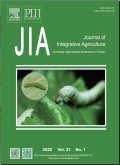首页|期刊导航|农业科学学报(英文)|Genome-wide association study of grain micronutrient concentrations in bread wheat
农业科学学报(英文)2024,Vol.23Issue(5):1468-1480,13.DOI:10.1016/j.jia.2023.06.030
Genome-wide association study of grain micronutrient concentrations in bread wheat
Genome-wide association study of grain micronutrient concentrations in bread wheat
摘要
关键词
bread wheat/nutritional element/GWAS/domestication/haplotypeKey words
bread wheat/nutritional element/GWAS/domestication/haplotype引用本文复制引用
Yongchao Hao,Xiaocun Zhang,Yan Zhao,Fanmei Kong,Lili Wang,Yu Zhao,Mengyao Li,Naixiu Che,Shuang Li,Min Wang,Ming Hao..Genome-wide association study of grain micronutrient concentrations in bread wheat[J].农业科学学报(英文),2024,23(5):1468-1480,13.基金项目
This work was supported by grants from the Natural Science Foundation of Shandong Province,China(ZR2020MC096,ZR2021ZD31,and ZR2020MC151)and the Agricultural Variety Improvement Project of Shandong Province,China(2021LZGC013 and 2022LZGC002). (ZR2020MC096,ZR2021ZD31,and ZR2020MC151)

